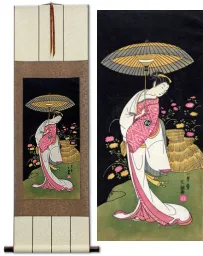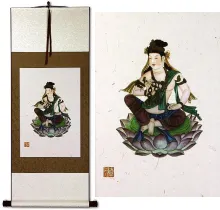This print features the actor Matsumoto Koshiro VII in the role of the white-bearded Ikyu, from the Kabuki play, "Sukeroku: Cherry-Blossom of Edo" which in Japanese is "助六由香里の江戸桜" or "助六由香里の江戸桜". This image is said to be from the scene 三浦屋格子先 or "Miuraya kōshi saki".
Ikyu was a wealthy old Samurai who attempted to intervene between the honorable man, Hanakawado Sukeroku, and a prostitute named Agemaki of the Miuraya house.
Original artist: Natori Shunsen / 名取春仙 (1886-1960).
Originally published by: Watanabe Shosaburo / 渡辺庄三郎.
Originally printed around March of 1929 during the Showa Era.
------------------------------------------------------
About Real Japanese Woodblock Prints:
Contrary to popular belief, woodblock printing (and in a way, the first printing press) was invented in China. Both artwork and whole books were produced in China using the woodblock print technique. Much of this artwork and printed books made their way to Japan. Emulating the methods and adding to the style, Japanese artists took woodblock printing to the next level.
In Japan, woodblock prints are known as 木版畫 or "Moku Hanga". Most were produced during the Edo period (1603–1867). To put that in perspective, that's from before what is now the USA was even a British colony, to just after the Civil War. Some artists continued creating prints into the early 1900s.
At that time, Japanese artists would deals create "template paintings" with detailed images of "everyday life" scenes of Japan. Some of these "everyday life" or 浮世絵 (Ukiyo-e), which translates as "Floating World" images, depict battling Samurai, beheadings, and even prostitution. This leads you to believe that "everyday life", was rather exciting in ancient Japan. However, most Ukiyo-e prints were more tame scenes of everything from women washing clothes, to men writing poetry.
After creating the template, the artist would then have another artisan carve large blanks of wood with those images. The carved wood blocks were then given to yet another artisan, known as an "inker". The inker would then carefully apply wet ink or colorful paint to the various carved surfaces. A sheet of handmade paper was then pressed over the inked woodblock to create the final print. The process was laborious, but not as tedious as hand-painting hundreds of copies from scratch.
------------------------------------------------------
About This Reproduction:
If this was an "original" Japanese woodblock print, dating back to the Edo period, the price would be anywhere from $800 to $20,000.
Just to be clear again: This is a reproduction.
The quality of this reproduction is very good, but a true expert will spot this as a reproduction after examining it.
I use handmade Kozo (mulberry) paper - the same kind of paper that Japanese woodblock print makers used centuries ago.
The pigment-based inks are archival and UV-resistant. In independent laboratory testing the giclée prints created with this ink should survive 95 to maybe more than 200 years with no signs of fading, if not in direct sunlight (most hand-painted artwork fades before that). I figure you'll get a lifetime of enjoyment if you take good care of this wall scroll. I spend hours making sure the colors are vibrant and touching up areas that might be damaged or missing from the old original print. The result is very close to what the woodblock print would look like if you could go back in time to the Edo period, and buy it from the artist's studio in old Japan.
After carefully printing and inspecting this artwork, I sent the raw print on Kozo paper to my workshop in Beijing where it was built into a handmade wall scroll. This makes it ready-to-hang (no expensive framing needed), and gives the whole piece a very traditional Asian look.
Product code: The Actor deals Matsumoto Koshiro as Ikyu - Japanese Woodblock Print Giclée Scroll


